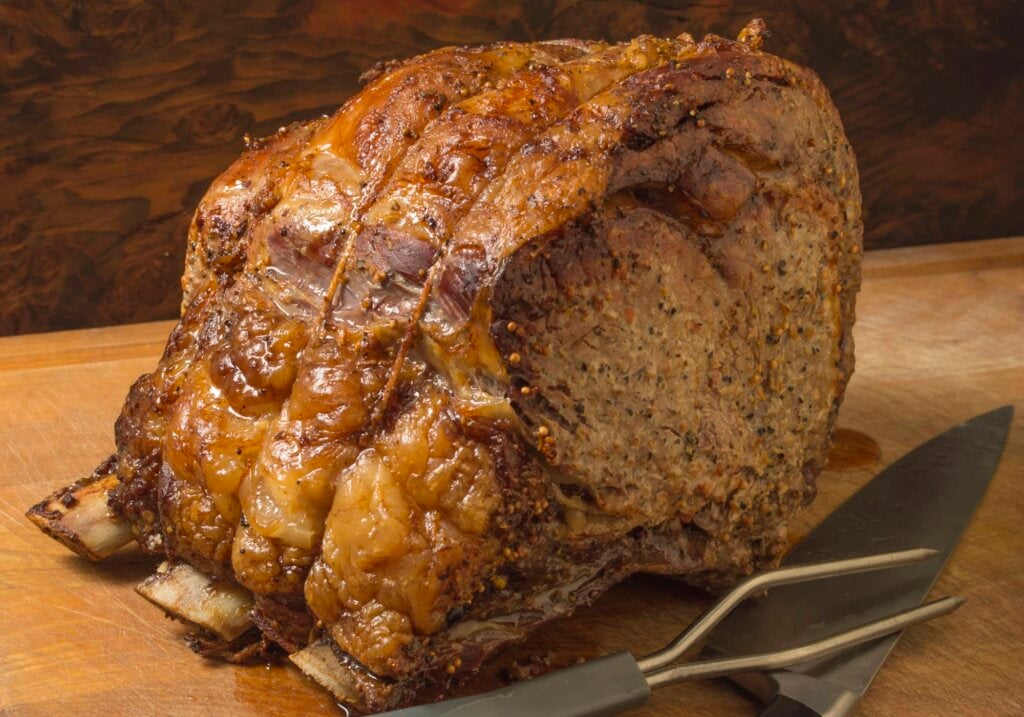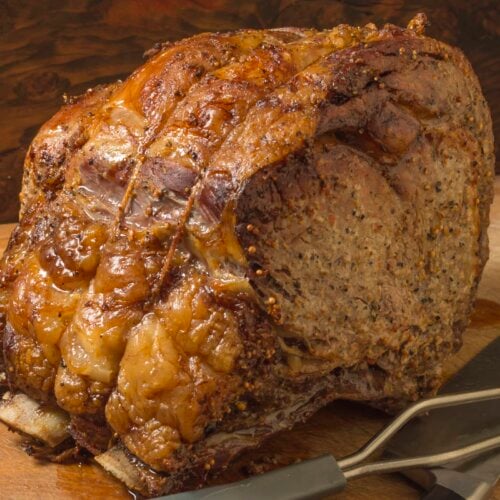
For a show-stopping beef roast worthy of a major event like a milestone anniversary or holiday dinner, turn to the classic Prime Rib. The bone-in roast in particular is a delicious and impressive cut of beef that has long been associated with fine dining and special events. If you’ve long enjoyed slices of Prime Rib sliced at a carvery but have never tackled the cooking process yourself, it’s easier than you might think. Prepare your very own bone in prime rib roast with this easy guide.
What is a Bone-In Prime Rib Roast?
The Prime Rib is the rear part of the cow’s ribs, from the 6th through the 12th rib bones. While the name includes the term prime, this is a reference to the fact that it comes from the primal cut of the rib area. Most Prime Rib roasts are actually USDA Choice grade meat, which is good but not quite the best. If you find a USDA Prime-grade Prime Rib, you’ve got the gold standard of roasts available to you. These roasts are often specialty ordered since they’re not as common as those that meet the USDA Choice grading requirements.
How to Prepare a Prime Rib Roast
This large beef roast can be trimmed so it’s boneless, but the bone-in variety is much more common. Most rib roast recipes are based around these full-sized cuts, which can weigh 15 pounds or more. Careful preparation of the meat before it goes into the oven or grill will result in tender, flavorful meat every time.
Bringing to Room Temperature
Almost all cuts of beef benefit from coming to room temperature before they are cooked. This is simple enough with a 2-inch thick steak because it rarely takes longer than 20 to 30 minutes. For a much larger roast like the Prime Rib, the process can stretch out to 3 to 4 hours instead. This is as long as you’ll want to leave beef out at room temperature without risking food safety issues. As soon as the Prime Rib reaches room temperature, begin cooking it. It can’t be returned to the refrigerator or frozen after that point.
Frenching the Bones
Cutting the meat back to expose more of the bone is known as frenching the roast. This involves scraping away all the tissue around the bone tips with a sharp knife. While this meat can be gnawed off the bone if it’s left in place, it’s not necessary to leave it in place if that’s not something you enjoy doing. A frenched Prime Rib has a neater and fancier appearance, and some butchers will do it for you upon request. If you want to do it yourself, hold the roast by the bone tips and use a sharp knife to slice down around each rib end. Then once you’ve disconnected the fat and meat from the bone, trim it loose with horizontal cuts toward the bone.
Trimming Fat
Most Prime Ribs sold today are trimmed just right for cooking. You want to leave a generous amount of the top fat cap on the roast since it adds flavor and juiciness as the meat cooks. However, fat layers thicker than 1 inch should be trimmed to avoid issues with heat penetration into the center of the roast.
Wrapping with Twine
Trussing the roast up with twine isn’t strictly necessary, especially if you don’t slice the roast up or try to french the bones. The meat should hold everything in place as it cooks, even as it contracts and shrinks. Trimmed and frenched Prime Rib roasts, especially boneless cuts, may need twine to hold them together so they cook evenly. If any part of your roast protrudes too far or flops out, you can always use butcher’s twine to ensure it stays juicy by sticking close to the rest of the meat.
Seasoning the Exterior
Marinating generally isn’t the best way to handle seasoning for a Prime Rib. Neither is wet brining the meat, which can make it gummy or chewy. Keep the roast dry and use a rub or dry seasoning mix over the surface for the best results.
Cooking Tips for Perfect Results
Use an instant-read thermometer when cooking the Prime Rib to ensure you reach the desired level of doneness. For best results, you want a probe-free design that reads the temperature without you having to poke the meat and wait. You can also find smaller rib roasts with only three to four ribs for smaller groups.
What to Do With Leftover Beef and Bones
The bones of the roast are always leftover, and they make great beef broth for your favorite soups and gravy dishes. Just simmer them in about 1 quart of water until the liquid becomes dark brown. For leftover meat, consider shaving it thinly and making roast beef sandwiches with horseradish or spicy mustard.
Bone-In Prime Rib Roast Recipe
Ingredients
- 1 Prime Rib or Standing Rib roast, 12 to 15 lbs
- 1 tablespoon Kosher salt
- 2 teaspoons garlic powder
- 2 teaspoons cracked black pepper
- 1 teaspoon olive oil
Instructions
1. Take the Prime Rib out of the refrigerator for about 2 to 3 hours before cooking it. Let it reach room temperature, then trim the fat and french the bones as desired. Rub the meat down with the olive oil, then rub the spices and seasonings into the surface as well.
2. Preheat the oven to 325 degrees F when the roast is nearly at room temperature. Place the Prime Rib in a large metal roasting pan on a rack and place it near the center of the oven’s height.
3. Roast the Prime Rib for about 12 to 15 minutes per pound of meat. Begin checking the meat after 2 hours of cooking time, or 1.5 hours for a smaller roast. When the internal temperature reaches 115 for medium rare or 125 for a medium roast, turn the oven up to 450 degrees F. Let the high temperatures sear the exterior for about 10 minutes, then take the roast out and let it rest for at least 20 minutes before carving.
Notes
Aim for a temperature about 15 degrees below the desired finished temperature when you begin searing the roast. This will bring the meat up another 10 degrees, then it will rise 5 degrees again while sitting and resting. Waiting until the level of doneness listed below will only leave it overcooked after searing and resting.
Bone-In Prime Rib Roast – Nutritional Facts
Per Serving (Based on a 2,000-Calorie Daily Diet)
| Nutrient | Amount (% DV) |
|---|---|
| Calories | 610 |
| Total Fat | 48g (62%) |
| Saturated Fat | 20g (100%) |
| Cholesterol | 145mg (48%) |
| Sodium | 340mg (15%) |
| Total Carbohydrate | 0g (0%) |
| Dietary Fiber | 0g (0%) |
| Sugars | 0g |
| Protein | 42g (84%) |
| Iron | 4.2mg (23%) |
| Vitamin C | 0mg (0%) |
| Calcium | 25mg (2%) |
| Potassium | 500mg (11%) |
Measuring Doneness for Bone-in Prime Rib Roast
The finished internal temperature of the Prime Rib roast, after resting, determines how well done it is. Most people prefer a medium rare to medium level of doneness for this kind of meat. Medium rare is 130 degrees F, and medium is 135 to 140 degrees F. Since this is a thick cut of meat, it won’t go beyond medium too quickly, so you can always return the meat to the oven if it’s a little pink or bloody for your tastes.
How to Carve a Rib Roast
Carving such a large hunk of meat requires a sharp knife you feel comfortable using. Let the meat cool enough that you can hold it with your bare hand without burning yourself. Place the roast fat side up and start each cut through the fat if possible. Grip the smaller section of the roast, then slice between the ribs starting at the thicker end. Once you have three to six large slabs of beef, you can hold the bone end to slice thinner pieces of meat off.
Conclusion
You’ll wow your guests when you bring out a massive piece of beef with a perfectly cooked tender pink center. Make the most of your investment in a quality Prime Rib from Chicago Steak Company with our tips on seasoning and cooking it.

Bone-In Prime Rib Roast
Ingredients
- 1 12-15lbs Prime Rib or Standing Rib roast
- 1 tbsp kosher salt
- 2 tsp garlic powder
- 2 tsp cracked black pepper
- 1 tsp olive oil
Instructions
- Take the Prime Rib out of the refrigerator for about 2 to 3 hours before cooking it. Let it reach room temperature, then trim the fat and french the bones as desired. Rub the meat down with the olive oil, then rub the spices and seasonings into the surface as well.
- Preheat the oven to 325 degrees F when the roast is nearly at room temperature. Place the Prime Rib in a large metal roasting pan on a rack and place it near the center of the oven’s height.
- Roast the Prime Rib for about 12 to 15 minutes per pound of meat. Begin checking the meat after 2 hours of cooking time, or 1.5 hours for a smaller roast. When the internal temperature reaches 115 for medium rare or 125 for a medium roast, turn the oven up to 450 degrees F. Let the high temperatures sear the exterior for about 10 minutes, then take the roast out and let it rest for at least 20 minutes before carving.

